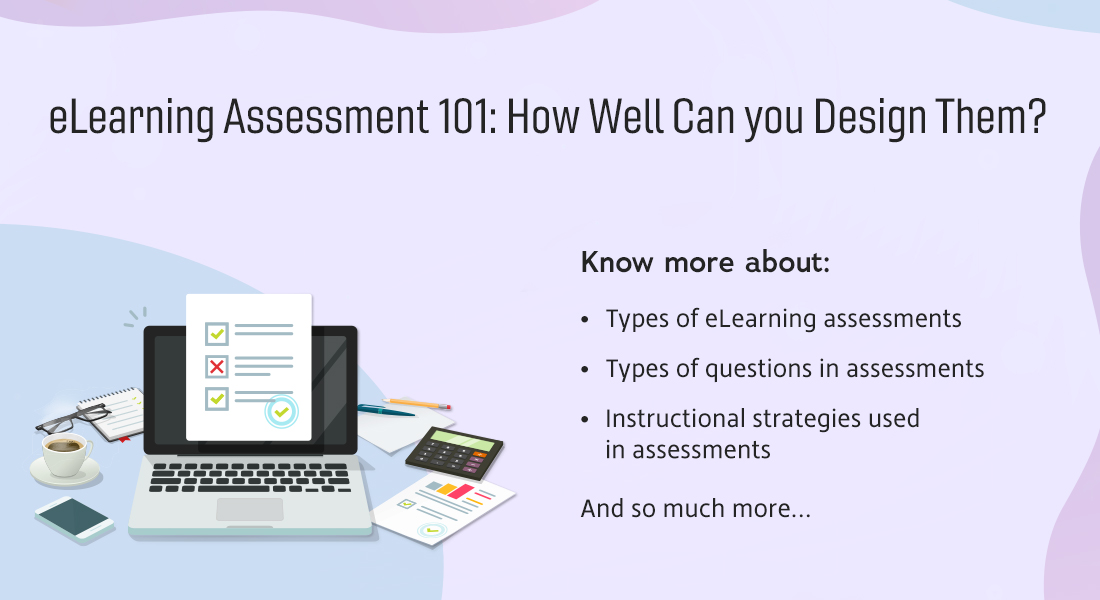Plan Your eLearning Assessments Like a Pro! [SlideShare]
![Plan Your eLearning Assessments Like a Pro! [SlideShare] Plan Your eLearning Assessments Like a Pro! [SlideShare]](https://blog.commlabindia.com/hubfs/Imported_Blog_Media/elearning-assessments-plan-slideshare.jpg)
Assessments are an essential part of any kind of training as they help assess the effectiveness of the training, whether the learning objectives were met. They become even more important in the context of online training. And for self-paced eLearning, assessments are one of the few ways to verify if the required learning is taking place. As a training manager, it is crucial to ensure your eLearning assessments are meaningful and effective, leading to successful learning that accelerates proficiency and performance!
In the spirit of understanding how to do that, let’s look at a few common mistakes that can creep in while designing eLearning assessments.
Steps to Plan eLearning Assessments
- Confirm Stakeholder Requirements
- Verify Objectives
- Select Optimal Assessment Type(s)
- Identify Assessment Constraints
Mistakes to Avoid when Designing eLearning Assessments
1. Posing Final Quiz Questions that are NOT aligned with the Learning Objectives
In summative assessments, we should stick to questions that are aligned with the performance-based learning objectives. For example, we need to refrain from testing learners on statistics that, though important to set the context for learning, in no way improve their on-the-job performance.
2. Framing eLearning Assessments after Designing the Entire Course
It is usually the practice of instructional designers to frame eLearning assessments after finishing the storyboard for the course. The disadvantage of this is that there will not be enough time to design intellectually challenging assessments.
Ideally, eLearning assessments should be framed immediately after determining the learning objectives of the course, so that enough time is spent on them to ensure they are perfectly aligned with the learning objectives.
What’s all the ado about learning objectives?
3. Using the Same Question Format Throughout for Formative Assessments
Formative assessments are a good way to reinforce learning, but not when using the same type of question throughout. Using engaging and stimulating formats of questions (instead of sticking to the same old MCQs) will help increase learner motivation. Question types that can be used in formative assessments include:
- Single/multiple select
- Matching, drag and drop, drop down
- Word builder
- Jigsaw puzzle
- Games
In fact, the sky is the limit!
Watch the mini masterclass on designing eLearning assessments.
4. NOT Providing Clear Instructions for eLearning Assessments
It is not a good practice to assume learners will know how to go about answering questions in complex templates and formats. Providing clear instructions that tell them how to approach a specific question is very important.
5. Scrimping on Feedback for Formative Assessments
Don’t just inform learners whether their response is right or wrong – explain why they are right or wrong. Provide the right answer in the feedback for eLearning assessments even when the learner answered correctly – to reinforce learning. You can also provide them with additional information about the topic when they are right.
So, how do you avoid making these mistakes? How do you optimize your eLearning assessments to ensure maximum learning? Well, consider your specific training needs and plan ahead. The SlideShare below takes you through the steps to plan effective eLearning assessments.
Parting Thoughts
We have explored in detail the ‘why’ and ‘how’ of planning eLearning assessments. We sure hope these insights will help you design and develop effective eLearning assessments. And in the same vein, access our free eBook to align your online training strategy with the eLearning trends for 2022 that are here to stay.





